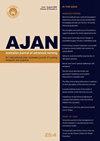Prehospital interventions to prevent hypothermia in trauma patients: a scoping review
IF 1.3
4区 医学
Q3 NURSING
引用次数: 3
Abstract
Objective: The aim of this review is to map the prehospital rewarming measures used to prevent hypothermia among trauma victims. Background: Hypothermia is responsible for an increase of the mortality and morbidity in trauma victims and its recognition and early treatment are crucial for the victim’s haemodynamic stabilisation. Prehospital interventions are particularly important, especially those that target bleeding control, haemodynamic stability, and safe body temperature. Registered nurses may be pivotal to prevention and minimisation of the dangerous effects of hypothermia. Study design and methods: A scoping review was used to identify articles from several online databases from 2010 to 2018. Studies in English, Spanish, and Portuguese were included. Two reviewers performed data extractions independently. Results: Seven studies were considered eligible for this review: two quantitative research studies, one qualitative research study, and four literature reviews. Rewarming measures can be divided into two main groups: passive rewarming, which includes the use of blankets, positioning the response unit to act as a windbreak, removing the patients’ wet clothes, drying the patient’s body, and increasing the ambient temperature; and active rewarming which includes the use of heating pads, heated oxygen, warmed intravenous fluids, peritoneal irrigation, arteriovenous rewarming, and haemodialysis. Discussion: Active measures reported by the included studies were always used as a complement to the passive measures. Active rewarming produced an increase in core temperature, and passive rewarming was responsible for intrinsic heat-generating mechanisms that will counteract heat loss. Patients receiving passive warming in addition to active warming measures presented a statistically significant increase in body core temperature as well as an improvement in the discomfort caused by cold. Conclusion: Rewarming measures seem to be essential for the prevention of hypothermia and to minimise the discomfort felt by the patient. In many countries registered nurses can play important roles in the prehospital context of trauma victim’s assistance. Greater understanding of these roles is necessary to the development of better practices. Implications for research, policy, and practice: The findings of this study highlight that passive and active rewarming measures must be implemented as soon as possible for trauma victims. Many measures are incorporated in trauma relief protocols; however, the lack of consensus on their inclusion results in an undervaluation of this issue, which inevitably compromises the safety and wellbeing of trauma victims. In practice, supportive frameworks and an intervention plan (based on heat loss reduction and heat supply) are required to ensure that first responders including registered nurses are able to prevent and treat hypothermia. What is already known about the topic?• Hypothermia is a serious threat to trauma victims in the prehospital context and can induce a “vicious cycle” of hypothermia, acidosis, and coagulopathy.• To prevent or control the decline of a trauma patient with hypothermia, treatment of hypothermia should ideally begin in the prehospital context.• Prehospital nurses must be able to develop advanced practice competence to function effectively in their role.What this paper adds:• This paper mapped out what measures can be used by prehospital healthcare workers including nurses.• This study identified all the rewarming measures that may improve the health and wellbeing of patients with hypothermia.• The combined use of active and passive measures seems to provide better outcomes in the prevention and treatment of hypothermia in trauma victims.预防创伤患者体温过低的院前干预:范围界定综述
目的:本综述的目的是绘制院前复温措施,以防止创伤患者体温过低。背景:低温是创伤患者死亡率和发病率增加的原因,其识别和早期治疗对受害者的血流动力学稳定至关重要。院前干预尤其重要,尤其是那些以出血控制、血流动力学稳定和安全体温为目标的干预。注册护士可能是预防和减少低温危险影响的关键。研究设计和方法:采用范围评价方法从2010年至2018年的几个在线数据库中确定文章。包括英语、西班牙语和葡萄牙语的研究。两名审稿人独立进行数据提取。结果:七项研究被认为符合本综述:两项定量研究,一项定性研究和四项文献综述。复温措施可分为两大类:被动式复温,包括使用毯子,将反应单元定位为防风林,脱去患者的湿衣服,使患者身体干燥,提高环境温度;主动复温包括使用加热垫,加热氧气,加热静脉液体,腹膜冲洗,动静脉复温和血液透析。讨论:纳入的研究报告的主动措施总是作为被动措施的补充。主动再暖产生核心温度的增加,而被动再暖负责内在的产热机制,将抵消热量损失。在主动加温措施的基础上,接受被动加温措施的患者,其核心体温有统计学上的显著升高,因寒冷引起的不适感也有所改善。结论:复温措施似乎是必不可少的,以防止体温过低,并尽量减少患者的不适感。在许多国家,注册护士可以在院前创伤受害者援助方面发挥重要作用。更好地理解这些角色对于开发更好的实践是必要的。对研究、政策和实践的启示:本研究的结果强调,必须尽快对创伤受害者实施被动和主动的复温措施。许多措施被纳入创伤救济方案;然而,由于缺乏对其纳入的共识,导致对这一问题的低估,这不可避免地损害了创伤受害者的安全和福祉。在实践中,需要支持性框架和干预计划(基于减少热损失和热量供应)来确保包括注册护士在内的急救人员能够预防和治疗体温过低。关于这个话题我们已经知道了什么?•低体温是院前创伤患者的严重威胁,可诱发低体温、酸中毒和凝血功能障碍的“恶性循环”。•为了预防或控制低温伤患者的衰退,理想情况下,应在院前开始低温治疗。院前护士必须能够发展先进的实践能力,有效地发挥其作用。本文补充的内容:•本文列出了院前医护人员包括护士可以使用的措施。•本研究确定了所有可能改善体温过低患者健康和福祉的复温措施。•主动和被动措施的联合使用似乎在预防和治疗创伤患者的低温方面提供了更好的结果。
本文章由计算机程序翻译,如有差异,请以英文原文为准。
求助全文
约1分钟内获得全文
求助全文
来源期刊
CiteScore
2.30
自引率
7.10%
发文量
27
审稿时长
>12 weeks
期刊介绍:
The Australian Journal of Advanced Nursing publishes a wide variety of original research, review articles, practice guidelines, and commentary relevant to nursing and midwifery practice, health- maternity- and aged- care delivery, public health, healthcare policy and funding, nursing and midwifery education, regulation, management, economics, ethics, and research methodology. Further, the journal publishes personal narratives that convey the art and spirit of nursing and midwifery.
As the official peer-reviewed journal of the ANMF, AJAN is dedicated to publishing and showcasing scholarly material of principal relevance to national nursing and midwifery professional, clinical, research, education, management, and policy audiences. Beyond AJAN’s primarily national focus, manuscripts with regional and international scope are also welcome where their contribution to knowledge and debate on key issues for nursing, midwifery, and healthcare more broadly are significant.

 求助内容:
求助内容: 应助结果提醒方式:
应助结果提醒方式:


